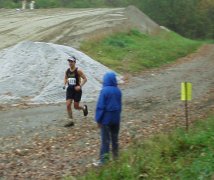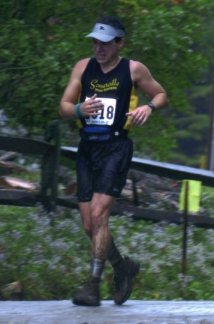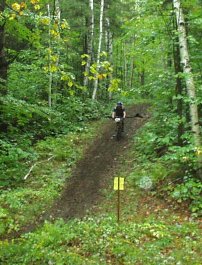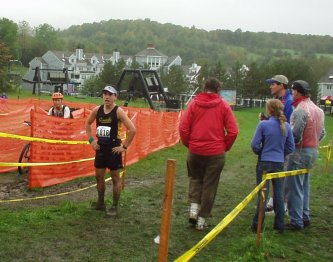Another story from 2003
The weekend after the Lake Winnipesaukee relay, I headed up to Brownsville, VT for the Vermont 50 ultramarathon. It’s a 50 mile trail race run at the same time as a 50K and a 50 mile mountain bike race. When I got there, once again I was struck by how beautiful the surrounding forest-covered mountains are, especially in the fall. The other thing that struck me was “Yikes! I’m about to run 50 miles, and there’s nothing around here but mountains.”
This was my first “real” ultramarathon. Earlier in the year, I ran over 40 miles in a couple of races, but both times that was as sort of a sideshow to the main event, so they were more along the lines of training runs. Also, they were short loop courses, so if something went wrong, at worst, I’d be no more than a mile and a half from help.
I had friends along to help (thanks, Mark and Karen!), but they were only allowed on the course at three of the nine aid stations. I wasn’t worried, but I was anxious.
There’s nothing in Brownsville other than the Ascutney Mountain Ski Area, where the race starts and finishes, and a small general store. So the race committee puts on a dinner at the town hall the night before the race. When I reached the dinner, it wasn’t hard to take a look at the body type of the diners and tell the runners from the bikers. The major topic for both groups was the forecast for race day, which called for lots of rain.
Sunday morning, we got up in the dark and went to the start for the pre-race meeting. It was about 60 degrees and cloudy, though the rain hadn’t started yet. First the bikers and then the runners took off under fairly comfortable conditions. I started at the back of the pack with the intention of going with a run 5 minutes/walk 1 minute pattern. That plan had served me fairly well at my previous long races, but those races were in the area surrounding Boston, on relatively flat, urban courses. In these mountains, it soon became obvious that I’d be better off running the downhills and (few) flats, and walking uphill.
 Within an hour, the rain started. That rain was destined to continue for the rest of the race. By the time I reached the third aid station, the first on the course where my friends could meet me with supplies, it had turned into a downpour. Usually, when over an inch of rain comes down during the course of a race, the water is the dominant theme to the story. In the Vermont 50, when the rain comes down like it did this year, the mountain bikes churn up the trails, and soon everyone is wallowing in a sea of mud.
Within an hour, the rain started. That rain was destined to continue for the rest of the race. By the time I reached the third aid station, the first on the course where my friends could meet me with supplies, it had turned into a downpour. Usually, when over an inch of rain comes down during the course of a race, the water is the dominant theme to the story. In the Vermont 50, when the rain comes down like it did this year, the mountain bikes churn up the trails, and soon everyone is wallowing in a sea of mud.
The mud was memorable. Sean Smith wrote “‘oceans of mud’ was the best way to describe conditions. I’d never seen mud do some of things I saw it do yesterday.” Doug Freese, who has run in all 11 Vermont 50s, said “never here, or at any other place for that matter, had I experienced these conditions for such an extended time.” Doug figures he lost about an hour and a half to the mud.
Relatively early in the race, I came up to yet another lake of mud of indeterminate depth. I looked down at it, and gave up. Instead of making even a token effort to keep my feet clean and dry, I just plowed straight through. It was oddly liberating. Later on, there wasn’t any option. To get ahead, I had to wade (or slide, if I was going downhill) through the mud. I just hoped that there weren’t any rocks buried underneath, a hope that wasn’t always met (ouch!). At one point, on an unusually steep uphill, I couldn’t get enough traction to make the climb. I had to find a stick that I could jam in the mud deep enough to use as a support while I climbed.
It wasn’t all about mud. Some of the race was on asphalt or hard-packed dirt roads. Early on, it was nice to get out of the mud for awhile. But running in pliant mud has its benefits. After 35 miles or so, it became painful to get out onto the hard surfaces. Because of the pain, by the end of the race, I was running just as slowly on the roads as I was in the mud. What was a pretty good pace in the mud was just a slow plod out on the road.
People always ask about the pain. “Doesn’t it hurt” ranks above even “You’re crazy”, and only slightly behind “I could never do that” (by the way, you could if you wanted to, though most people have to really want to). Yes, it hurts, but it’s almost always pain you can ignore. Pain that’s ignored long enough goes away, or at least, gets replaced by other pains.
 Coming into aid stations was always fun. They were the only markers that allowed me to measure my progress. The best aid stations were on mountain top meadows, affording a short respite after a long climb. At the aid stations, I could have a shot of Hammer Gel, refill my bottle with Succeed (or with Accelerade, if my friends had access to the station), and get a bit of encouragement from the volunteers before heading on. I kept it simple, and stuck with gels and Succeed/Accelerade throughout the race. It worked pretty well. I didn’t have any real bad patches where I ran out of gas. Other people ate the solid food available at the stations. Things were going well enough that it wasn’t worth the risk for me, though the hot soup at one station was very tempting!
Coming into aid stations was always fun. They were the only markers that allowed me to measure my progress. The best aid stations were on mountain top meadows, affording a short respite after a long climb. At the aid stations, I could have a shot of Hammer Gel, refill my bottle with Succeed (or with Accelerade, if my friends had access to the station), and get a bit of encouragement from the volunteers before heading on. I kept it simple, and stuck with gels and Succeed/Accelerade throughout the race. It worked pretty well. I didn’t have any real bad patches where I ran out of gas. Other people ate the solid food available at the stations. Things were going well enough that it wasn’t worth the risk for me, though the hot soup at one station was very tempting!
In a 50 mile race, almost everyone is either settled into their pace, or slowing down as things begin to go wrong. I was pleased with how I held my pace. I slowed down as time went on, but never had a crisis to work through (though some aid stations did seem further apart than expected). Starting at about 20 miles or so, I began passing the people I’d let go at the beginning of the race. No one was passing me. Whenever I saw someone appear ahead of me, I felt it was just a matter of time before I’d run them down. That was very satisfying. I wasn’t going to win anything, but I was managing my race well.
 Most of the way around, the course was well marked well. Yellow tags with black arrows directed me around turns, or reassured me that I was on the correct path. There was one point in the middle of the race where a downhill stretch of single-track trail fed into a dirt road at an angle. The correct turn was a sharp cut back to the right, impossible for a bike to take at full speed. As I approached the turn, a bike whizzed by and zoomed off in the wrong direction. Two runners followed him, but when I got to the turn and could see they’d headed off incorrectly, I was able to yell loud enough to get them to turn around.
Most of the way around, the course was well marked well. Yellow tags with black arrows directed me around turns, or reassured me that I was on the correct path. There was one point in the middle of the race where a downhill stretch of single-track trail fed into a dirt road at an angle. The correct turn was a sharp cut back to the right, impossible for a bike to take at full speed. As I approached the turn, a bike whizzed by and zoomed off in the wrong direction. Two runners followed him, but when I got to the turn and could see they’d headed off incorrectly, I was able to yell loud enough to get them to turn around.
The positive karma I built up there didn’t keep me from getting lost later in the race. I was cruising along a road, pulling ahead of a couple of runners I’d caught at the sixth aid station. I hadn’t seen a yellow tag for awhile, but I wasn’t worried until I saw a police car in the road ahead of me with its flashers going. That was usually a sign of a crossing, not just a turn. At the same time I could just hear the runners behind me yelling. I turned and saw them waving back up at the top of the hill I’d just descended. I realized I’d misses a turn somewhere, and headed back. Unfortunately, by the time I got back uphill, the runners who had been following me had disappeared. I continued on, hoping to find the correct turn, but I didn’t, and as I went on, the road became less familiar, making me think I might not be retracing my path correctly.
At that point, I noticed a biker off in the woods to my left. I asked him where he was, and he told me he was about a half-mile past the seventh aid station. Since I’d know where I was at least, I got back on the trail and headed backwards, intending to find where I lost the trail and then turn around. I went up and down a few hills, backwards through the seventh aid station, running in the opposite direction of a number of very surprised runners and bikers.
After first running over 30 miles forwards, then spending all that time heading backwards, I was getting pretty anxious, and not thinking as clearly as I needed to be. According to the rules, I was supposed to get back on the trail where I got off. Finally, I got back to the police car where I first realized I’d gotten lost. Since I didn’t really know where I’d left the trail, I talked myself into thinking I’d spent enough time wandering around, and turned towards the finish.
A few people passed me soon after I started heading forward again, indicating that I might have skipped ahead and gotten in with some faster runners. After the race, I got the splits from the timing company. I went from 29th place at the sixth station to 20th at the seventh station. Comparing my time for the seventh leg to other runners who were going at a similar pace, I figured that I probably cut my total time down by about 25 minutes, in addition to not running the correct course.
Because I didn’t run the correct course, the week after the race, I emailed the race director and disqualified myself. That hurt a bit, but even if no one else knew, I would have known that I’d cut things short, and I couldn’t let myself get away with that.
I spent the final ten miles of the race passing and being passed by Audrey Rue Nelson from Oregon, as we waded through more mud, forded various flash floods, climbed more mountains, and made silly remarks as we passed each other. I ended up finishing about 20 seconds ahead of her. I know I it helped me to have someone to compete with for the last stretch. I hope it helped her just as much, as she really should have finished ahead of me.
 Finally, after ten hours, one minute, and 22 seconds, I finished. As you can see in the picture, I just stood there stunned. I had to readjust to having to think about what I’d be doing, rather than mindlessly engaging in Relentless Forward Progress. My friends helped me get my jacket on, I poked at the post-race barbeque without really feeling hungry, and then we went back to the hotel, out of the rain, where I could have a bit of food and a shower.
Finally, after ten hours, one minute, and 22 seconds, I finished. As you can see in the picture, I just stood there stunned. I had to readjust to having to think about what I’d be doing, rather than mindlessly engaging in Relentless Forward Progress. My friends helped me get my jacket on, I poked at the post-race barbeque without really feeling hungry, and then we went back to the hotel, out of the rain, where I could have a bit of food and a shower.
After I hosed off the mud, I took stock. In spite of all the water and mud in my shoes, I only had one blister, which hadn’t bothered me at all during the race. My legs were a bit more tired than they would be after a marathon, but recovery followed the normal pattern, and by Thursday, I could walk down stairs without holding on to the railing. My feet were more battered than usual, having come up against more than one rock buried in the mud. They were somewhat swollen and bruised, with some scrapes on the inside of both ankles from the opposite shoe rubbing against them. The left foot was a bit more beaten, with two black toenails and some skin worn off between the toes. All in all, I came through the race pretty well.
Some people run for fitness, some run for competition or the companionship of people that are also drawn to running. I enjoy those things, but I get the most pleasure from the way the consistent high effort towards a clear goal and metronomic running action combine to focus my attention on what I’m doing at the moment, with no worries about what happened in the past, and no anxiety about what might happen in the future. Nothing but running gets me into that zen-like state of calm effort. Ten hours of that is something incredibly valuable to me. The only comparable experience I’ve had was my first Boston Marathon. Of course, in that race I set a PR, and in this race, I was disqualified. Guess I’ll just have to do it again!
